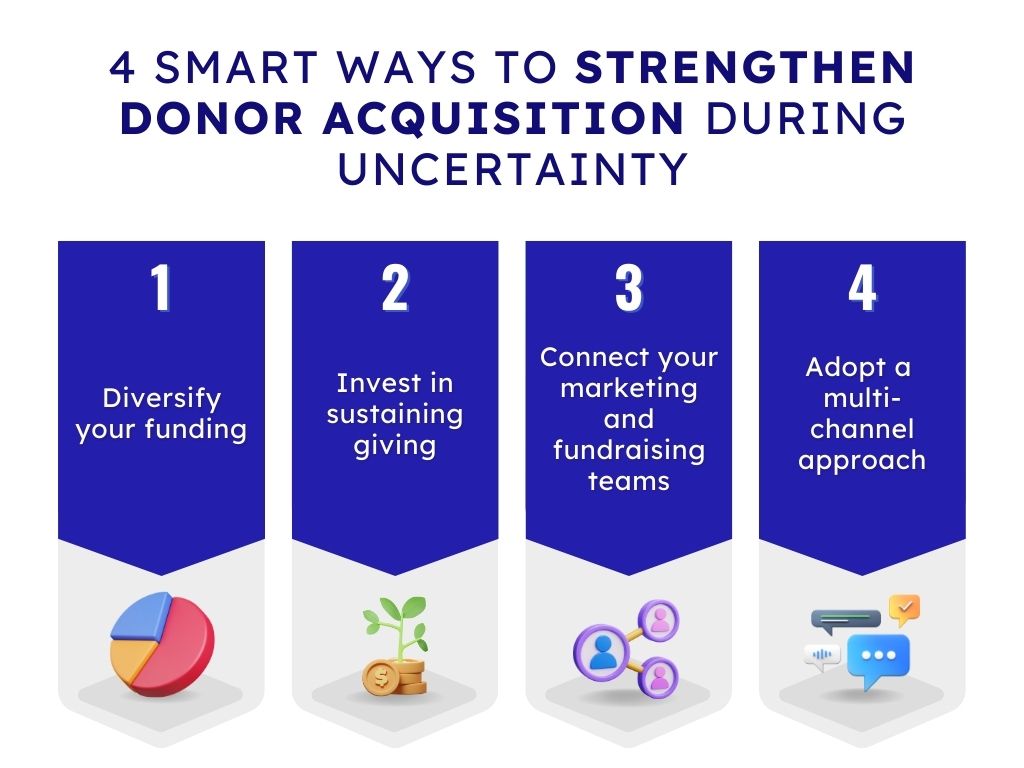Facing Budget Cuts? Now Is the Time to Invest in Acquisition

If one word could sum up 2025’s first quarter, it’s “change.” For many nonprofits, shifts in funding sources — like recent adjustments to USAID allocations — have prompted a fresh look at how to sustain and grow revenue in the months ahead.
In the face of sudden budget cuts, it can be tempting to pull back fundraising strategies like acquisition in favor of doubling down on raising support from their existing loyal donors. After all, it costs about five times more to acquire a new donor than to retain one. But this moment also presents a valuable opportunity to reassess, refocus, and build smarter strategies for growth.
Whether you’re navigating a funding gap or proactively future-proofing your fundraising, we’ve got practical tips to help. Let’s explore how your acquisition efforts can play a critical role in strengthening your long-term revenue outlook.
Common Knee-Jerk Reactions to Avoid
A big lesson from the USAID cuts is that government funding is unreliable. If you depend on federal grants for a significant portion of your operating budget, you’ll need a new revenue stream. Current donors — even the most loyal ones — will only take you so far.
Over decades of working with nonprofits, we’ve watched acquisition efforts get scaled back or eliminated when budgets are cut. This often comes as a pullback on media spending, which is usually a large dollar amount. Organizations will also lower their testing budget and reallocate those funds toward strategies they know work.
While it makes sense to invest in low-risk efforts, it’s essential to think long-term. Looking at performance data over several years, you can see craters. Nonprofits that pull back from acquisition in economically conservative moments pay the price later.
In the best of times, the average donor retention rate hovers around 40–45%. Attrition is natural, so you must acquire new donors to replace the ones you lose. Your donors may have to give less due to their own financial troubles, and you’ll need new ones to make up for the lost ground.
Unsure where to turn to during these times?
Determining Your Next Right Move
If your organization has been affected by recent federal budget cuts, there are a few things you can do to make up for the lost revenue. But remember, whatever you do next must be natural for your nonprofit. Let your current donors guide you.
Nail Down Your Messaging
A sudden loss of revenue due to forces beyond your control can make for an incredibly compelling appeal. However, knowing how to say this in a way that resonates with existing and potential supporters is critical.
Should you call out the challenge by name? Use more aggressive language to attract rage givers? Or should you take a more delicate and balanced approach? Testing will help you determine the right path, so don’t reallocate that budget just yet.
Most importantly, be open to trying new messaging. These unprecedented federal cuts may warrant a response that deviates from your usual tone or voice.
Lean Into Your Work and Its Impact
If you’re uncomfortable talking explicitly about the reasons behind your budget shortfall, that’s okay. Your donors have a wide range of belief systems and support you for various reasons. You don’t want to risk alienating anyone.
Instead, talk about your mission. Clearly outline the issue you seek to solve. Share whether it’s facing new challenges or has an additional need. Then, show your on-the-ground work and its impact. This type of messaging will deepen relationships with those who already support you.
Dig Into Your Data
Donor data is your compass on this new journey. You must know who your donors are and what they care about to develop messaging that will move them — and others like them — to action.
Testing is critical here, too, because data will only tell you part of the story. For instance, some prospects may not like the current administration’s direction and just want to be angry. While they might donate to you in this difficult moment, they likely won’t care enough about your cause to stick around long-term.
On the other hand, some people may want more government efficiency and support the spending cuts. But they don’t want to see the nonprofits they care about be negatively affected, so their passion for your mission could grow.
How to Weather the Storm

Whether you’re anticipating budget cuts or just worried because of what we’ve seen so far this year, don’t wait to act. The sooner you can incorporate some of these tips, the stronger your nonprofit will be.
- Diversify your funding. Don’t rely on one acquisition model. Test other programs that could work well together, like direct mail and digital. Acquire someone with a strong printed piece, then support them through digital ads, emails, and your website.
- Invest in sustaining giving. Monthly giving programs mean reliable support. Take steps to turn more one-time donors into regular donors. For instance, default to sustaining giving on your donation forms or set up a Sustainer Day to promote the benefits of monthly gifts.
- Connect your marketing and fundraising teams. Start building bridges between these departments so they can share resources like donor details and even funding. This way, your marketing team can better tell your story and create out-of-funnel and top-of-funnel activities that convert.
- Adopt a multi-channel approach. Don’t just strip out an entire channel if you need to pull back. Instead, decrease your budget a little across all channels. Today’s donor behavior is multi-channel; the most effective nonprofits know what platforms their supporters use and meet them there.
If these suggestions seem unattainable, then simply start where you are and with what you have. Look at where you’re struggling and take baby steps to find the answers.
- Can’t get your marketing and fundraising teams on the same page? Build a coordinated communications calendar.
- Overwhelmed by digital advertising? Start with a small budget on a platform you’re comfortable with.
- Need to test your messaging? Use the A/B testing function in your email program, then roll the findings out on other channels.

Lean Into Your Opportunities
When people face unexpected cuts or restraints, their first instinct is to shrink into a fixed mindset — they only focus on the limitations. This way of thinking hinders their ability to be creative, think outside the box, and find solutions.
Don’t fall into this trap. Instead, look for the possibilities and opportunities these challenges present. For instance, you might explore partnerships with peers in other departments or complementary organizations in your space.
Hard times can lead to hard conversations, and you may disagree with your leadership or board’s direction. Lean into your expertise and experience and push back when you know there’s a better solution. Some investments may not pay off immediately but will have a longer-lasting effect in the future. Back your ideas up with data.
Finally, stay true to your mission. Never doubt the importance of your work. Reach out to other fundraisers for support and continue advancing your life-changing vision. And if you need expert guidance to navigate this difficult time, connect with our Allegiance Group + Pursuant team.
This blog is based on an episode of the Go Beyond Fundraising podcast. Listen to the complete conversation now.